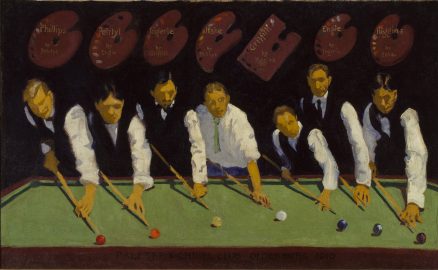Untitled (At Oldenburg)
, dated 1910Oil on canvas, 22¼ by 36¼ inches
- Categories
- Portraits
- Zoom in on Artwork
- Print Page
- Email Page to Friend
This unusual work is a cooperative group portrait made by seven members of Chicago’s Palette and Chisel Club. Shown bending over the far side of a pool table, each artist is poised to strike a ball with the tip of his cue. All in shirtsleeves, they form a rhythmic series of black and white forms interrupted by the central figure of Otto Hake: the only man not wearing a vest over his white shirt, he sports distinctive round spectacles and a green tie. Above each figure on the dark background hangs his painting palette inscribed with his name and that of the artist who presumably painted him. Each man is individualized in pose, stature, and facial features: the third from the left, for example, is clearly distinguishable as Rudolph Ingerle by his goatee. Yet the faces are generalized and the manner in which the figures are painted is notably uniform, as if the portraitists collectively strove for a consistent effect. The balls spread across the smooth green surface of the pool table in an irregular line follow the order of the color spectrum, mimicking the arrangement of dabs of pigment on each of the palettes above. These are subtly varied as to shape, with L. O. Griffith’s rectangular palette standing out visually among them.
According to the inscription across the bottom edge of the canvas, the painting was made during an excursion to Oldenburg, Indiana, in 1910. As early as the 1890s, artists from Chicago traveled out of the city in the summer to paint the rural landscape and to study the figure posed outdoors in natural light. Members of the Palette and Chisel Club established a seasonal rustic camp at Fox Lake, Illinois, in 1905; in subsequent summers they also visited Brown County, Indiana, and the St. Joe River in Michigan. In late September 1910, according to newspaper accounts, Victor Higgins led a group of seven fellow club members to the “quaint German village” of Oldenburg in east-central Indiana, where, “planted in the midst of modern American civilization, exists a typical hamlet of the old world with its characteristic traditions.”i Finding that “the surrounding country . . . would furnish a life-time’s work to the most active and able artists,” the group settled in for “two weeks of hard work.”ii They found accommodations at the Gibson Hotel, whose proprietor, Joseph Merchen, also ran one of six local saloons undoubtedly furnished with pool tables. The hotel hosted a display of 130 landscape sketches the artists made while in Oldenburg. Later, the sketches which were also shown back in Chicago on the Palette and Chisel’s premises. This group portrait was probably not among them, however: its provenance indicates that the artists left it behind in Oldenburg after their stay, perhaps in gratitude for an enjoyable and productive visit.
Wendy Greenhouse, PhD
Donated by M. Christine Schwartz to the Newberry Library, Chicago, Illinois, in 2023
i “Artists from Chicago Spend Two Weeks at Oldenburg Making Landscape Sketches,” Brookville Democrat, Oct. 6, 1910; Chicago Record-Herald, Nov. 20, 1910, in Art Institute of Chicago Scrapbooks, v. 27, Ryerson and Burnham Libraries, Art Institute of Chicago.
ii “Academy Echoes,” unidentified newspaper clipping dated from Oldenburg, Indiana, Sept. 30, 1910, in Palette and Chisel Club Logbooks, v. 2, on deposit in the Newberry Library.
